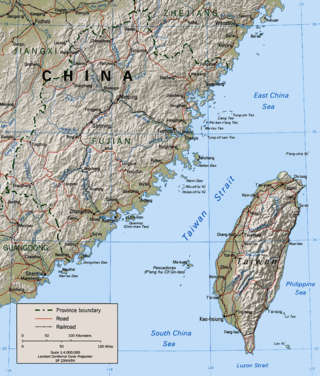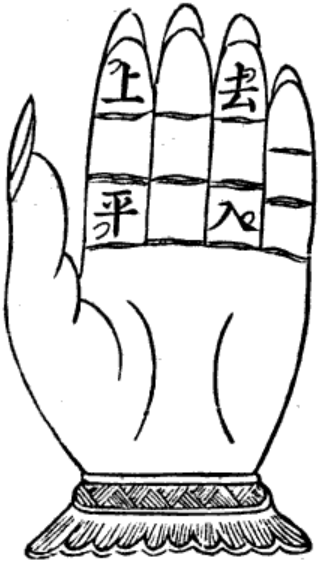
The International Phonetic Alphabet (IPA) is an alphabetic system of phonetic notation based primarily on the Latin script. It was devised by the International Phonetic Association in the late 19th century as a standard written representation for the sounds of speech. The IPA is used by lexicographers, foreign language students and teachers, linguists, speech–language pathologists, singers, actors, constructed language creators, and translators.
Hanyu Pinyin, or simply pinyin, is the most common romanization system for Standard Chinese. In official documents, it is referred to as the Chinese Phonetic Alphabet. Hanyu literally means 'Han language'—that is, the Chinese language—while pinyin literally means 'spelled sounds'. Pinyin is the official system used in China, Singapore, Taiwan, and by the United Nations. Its use has become common when transliterating Standard Chinese mostly regardless of region, though it is less ubiquitous in Taiwan. It is used to teach Standard Chinese, normally written with Chinese characters, to students already familiar with the Latin alphabet. Pinyin is also used by various input methods on computers and to categorize entries in some Chinese dictionaries.

Wade–Giles is a romanization system for Mandarin Chinese. It developed from the system produced by Thomas Francis Wade during the mid-19th century, and was given completed form with Herbert Giles's A Chinese–English Dictionary (1892).
Tone is the use of pitch in language to distinguish lexical or grammatical meaning—that is, to distinguish or to inflect words. All oral languages use pitch to express emotional and other para-linguistic information and to convey emphasis, contrast and other such features in what is called intonation, but not all languages use tones to distinguish words or their inflections, analogously to consonants and vowels. Languages that have this feature are called tonal languages; the distinctive tone patterns of such a language are sometimes called tonemes, by analogy with phoneme. Tonal languages are common in East and Southeast Asia, Africa, the Americas and the Pacific.
Tone sandhi is a phonological change that occurs in tonal languages. It involves changes to the tones assigned to individual words or morphemes, based on the pronunciation of adjacent words or morphemes. This change typically simplifies a bidirectional tone into a one-directional tone. Tone sandhi is a type of sandhi, which refers to fusional changes, and is derived from the Sanskrit word for "joining."

The Linguistic Society of Hong Kong Cantonese Romanization Scheme, also known as Jyutping, is a romanisation system for Cantonese developed in 1993 by the Linguistic Society of Hong Kong (LSHK).
In linguistics, a consonant cluster, consonant sequence or consonant compound, is a group of consonants which have no intervening vowel. In English, for example, the groups and are consonant clusters in the word splits. In the education field it is variously called a consonant cluster or a consonant blend.
Taishanese, alternatively romanized in Cantonese as Toishanese or Toisanese, in local dialect as Hoisanese or Hoisan-wa, is a Yue Chinese dialect native to Taishan, Guangdong.

The Yi scripts are two scripts used to write the Yi languages; Classical Yi, and the later Yi syllabary. The script is historically known in Chinese as Cuan Wen or Wei Shu and various other names (夷字、倮語、倮倮文、畢摩文), among them "tadpole writing" (蝌蚪文).
General Chinese is a diaphonemic orthography invented by Yuen Ren Chao to represent the pronunciations of all major varieties of Chinese simultaneously. It is "the most complete genuine Chinese diasystem yet published". It can also be used for the Korean, Japanese, and Vietnamese pronunciations of Chinese characters, and challenges the claim that Chinese characters are required for interdialectal communication in written Chinese.
A checked tone, commonly known by the Chinese calque entering tone, is one of the four syllable types in the phonology of Middle Chinese. Although usually translated as "tone", a checked tone is not a tone in the phonetic sense but rather a type of syllable that ends in a stop consonant or a glottal stop. Separating the checked tone allows -p, -t, and -k to be treated as allophones of -m, -n, and -ng, respectively, since they are in complementary distribution. Stops appear only in the checked tone, and nasals appear only in the other tones. Because of the origin of tone in Chinese, the number of tones found in such syllables is smaller than the number of tones in other syllables. Chinese phonetics have traditionally counted them separately.
The Yale romanization of Cantonese was developed by Yale scholar Gerard P. Kok for his and Parker Po-fei Huang's textbook Speak Cantonese initially circulated in looseleaf form in 1952 but later published in 1958. Unlike the Yale romanization of Mandarin, it is still widely used in books and dictionaries, especially for foreign learners of Cantonese. It shares some similarities with Hanyu Pinyin in that unvoiced, unaspirated consonants are represented by letters traditionally used in English and most other European languages to represent voiced sounds. For example, is represented as b in Yale, whereas its aspirated counterpart, is represented as p. Students attending The Chinese University of Hong Kong's New-Asia Yale-in-China Chinese Language Center are taught using Yale romanization.
Yi Syllables is a Unicode block containing the 1,165 characters of the Liangshan Standard Yi script for writing the Nuosu language.
Tone letters are letters that represent the tones of a language, most commonly in languages with contour tones.
The phonology of Standard Chinese has historically derived from the Beijing dialect of Mandarin. However, pronunciation varies widely among speakers, who may introduce elements of their local varieties. Television and radio announcers are chosen for their ability to affect a standard accent. Elements of the sound system include not only the segments—e.g. vowels and consonants—of the language, but also the tones applied to each syllable. In addition to its four main tones, Standard Chinese has a neutral tone that appears on weak syllables.
The phonology of Burmese is fairly typical of a Southeast Asian language, involving phonemic tone or register, a contrast between major and minor syllables, and strict limitations on consonant clusters.
Standard Cantonese pronunciation originates from Guangzhou, also known as Canton, the capital of Guangdong Province. Hong Kong Cantonese is closely related to the Guangzhou dialect, with only minor differences. Yue dialects spoken in other parts of Guangdong and Guangxi provinces, such as Taishanese, exhibit more significant divergences.

The four tones of Chinese poetry and dialectology are four traditional tone classes of Chinese words. They play an important role in Chinese poetry and in comparative studies of tonal development in the modern varieties of Chinese, both in traditional Chinese and in Western linguistics. They correspond to the phonology of Middle Chinese, and are named even or level, rising, departing or going, and entering or checked. They are reconstructed as mid, mid rising, high falling, and mid with a final stop consonant respectively. Due to historic splits and mergers, none of the modern varieties of Chinese have the exact four tones of Middle Chinese, but they are noted in rhyming dictionaries.
The Fuqing dialect, or Hokchia, is an Eastern Min dialect. It is spoken in the county-level city of Fuqing, China, situated within the prefecture-level city of Fuzhou. It is not completely mutually intelligible with the Fuzhou dialect, although the level of understanding is high enough to be considered so.

Teochew Romanization, also known as Swatow Church Romanization, or locally as Pe̍h-ūe-jī, is an orthography similar to Pe̍h-ōe-jī used to write the Chaoshan dialect. It was introduced by John Campbell Gibson and William Duffus, two British missionaries, to Swatow in 1875.